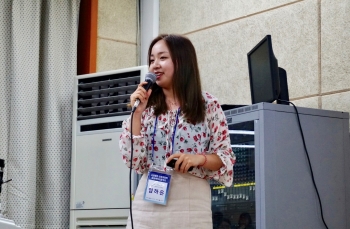
Yum Ha-eun, a junior majoring in Division of Mechanical and Biomedical Engineering (DMBE), published a paper in an Science Citation Index (SCI) journal as a lead author last June. The paper was put on the online edition of Journal of the Mechanical Behavior of Biomedical Materials (JMBBM), an SCI-listed international scientific journal.
The title of the paper was “Investigation of the relationship between localized cumulative stress and plantar tissue stiffness in healthy individuals using the in-vivo indentation technique.” The research aimed to determine whether repetitive and prolonged exercise stiffens the plantar soft tissue. It was conducted in cooperation with the Department of Dance to compare the stiffness of plantar tissues of an ordinary man with those of a dance major student.
Among the seven co-authors, Yum’s name was placed first on the paper. As it is rare for an undergraduate to be named lead author, Ewha Voice met Yum to get a glimpse of her efforts and how it was like to be a part of the first batch of DMBE. She is also currently working as an intern at Biomedical Mechanics and Materials Laboratory since 2017.
According to Yum, her initial inspiration for the paper was her curiosity in human movements.
“I loved watching sports programs ever since I was in high school,” Yum said. “Since then, I’ve always wanted to study more on active movements of humans. This naturally led me to conduct this research.”
Yum further explained how she came to work with the Department of Dance during her research. As her academic advisor’s office was located in the Physical Education Building, her academic advisor was acquainted with another professor in the Department of Dance.
“In previous studies, there was lack of research on the material property of healthy individuals’ plantar tissues,” Yum commented. “So, we decided to write a paper on this topic with the cooperation of the Department of Dance.”
When submitting a paper to JMBBM, all researchers must go through a revision process in which anonymous reviewers criticize the paper’s doubtful points and flaws. Yum dealt with the revision process all by herself after submitting the paper in which she believes made a major contribution to the success of the research.
“It was crucial to pass that process in order to get accepted by the journal - or else our paper would have been rejected,” Yum remarked. “I think my contribution to the revision was the main reason why I was titled lead author.”
Being an undergraduate student in the lab, Yum had a lot to share when asked about the difficulties that she faced when writing the paper.
“The main difficulty was my lack of experience,” Yum replied. “To add onto that, it was even harder to get advice from other people. The Division of Mechanical and Biomedical Engineering was newly established in 2017, so we didn’t have many graduate students in our lab. The only two graduate students we had were not from engineering-related departments. Therefore, conducting experiments during the research solely rested upon us.”
On the other hand, Yum explained that this was also the reason how she could get the opportunity to be part of the research. Because their lab lacked graduate students, undergraduates were given opportunities to write papers.
“I expect that this research will contribute a lot in the health section regarding the diagnosis of diabetes,” Yum remarked. “People with diabetes usually have a diabetic foot. Previously, Nervous Conductive Test was used to diagnose diabetic foot, which was expensive and inaccurate. Through our research, the possibility of diagnosing this disease using stiffness, not nerves, has been revealed. It would help people find out about their illness earlier than before.”
Yum anticipates that if the data on the stiffness of plantar tissue are accumulated, it would be possible to diagnose diabetes with a machine called “indenter” at a very early stage.
“I realized how much I like to help people through this experience,” Yum concluded. “I wish to keep studying in this field, biomechanics, and become a professor in the future.”

